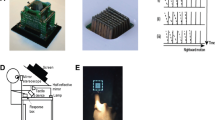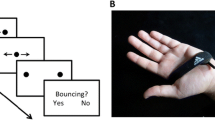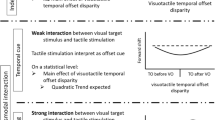Abstract
Responses to multiple stimuli from different modalities tend to be faster compared to responses to each of these stimuli alone. Neurophysiological studies on higher mammals and behavioral studies on humans suggest that the relative amount of enhancement is inversely related to stimuli intensity. In two experiments the duration of visual and tactile stimuli was varied to investigate whether duration, as a further determinant of stimulus effectiveness, is also inversely related to the relative amount of response enhancement. Visual and tactile stimuli were presented left or right of fixation either in the same or different hemifields. Participants were required to gaze only at visual stimuli and to ignore tactile (focused attention paradigm). Saccadic reaction times were recorded. Results from both experiments show that the relative amount of response enhancement was largest for the shortest stimulus duration and decreases with increasing stimulus duration, i.e., inverse effectiveness of stimulus duration.


Similar content being viewed by others
Notes
Stimulus durations were determined in unimodal pilot studies such that: (a) RT decreased monotonically with increasing stimulus duration, (b) difference in RT was as large as possible between the shortest and longest durations, and (c) steps between the lower four durations were equal in size for each modality. The longest condition (500 ms) was added to allow comparisons to earlier experiments.
Participant SL performed saccades that systematically overshot beyond the position of the target. This resulted in a higher mean amplitude and a larger scatter.
This strongly suggests that participants responded according to the FAP, i.e., ignored the non-target. Otherwise, many more direction errors should have been observed on contralateral trials than on ipsilateral.
Participant IM performed saccades that systematically overshot beyond the position of the target. This resulted in a higher mean amplitude and a larger scatter.
References
Amlôt R, Walker R, Driver J, Spence C (2003) Multimodal visual–somatosensory integration in saccade generation. Neuropsychologica 41:1–15
Arndt PA, Colonius H (2003) Two stages in crossmodal saccadic integration: evidence from a visual–auditory focused attention task. Exp Brain Res 150:417–426
Becker W (1991) Saccades. In: Carpenter RHS (ed) Eye movements. Vision and visual dysfunction, vol 8, ch 5. Macmillan Press, Houndmills Basingstoke Hampshire, London, pp 95–137
Bell AH, Meredith MA, Van Opstal AJ, Munoz DP (2005) Cross-modal integration in the primate superior colliculus underlying the preparation and initiation of saccadic eye movements. J Neurophysiol 93:3659–3673. DOI 10.1152/jn.01214.2004
Bernstein IH, Clark ME, Edelstein BA (1969) Effects of an auditory signal on visual reaction time. J Exp Psychol 80(3):567–569
Bernstein IH, Rose R, Ashe VM (1970) Energy integration in intersensory facilitation. J Exp Psychol 86(2):196–203
Bernstein IH, Chu PK, Briggs P, Schurman DL (1973) Stimulus intensity and foreperiod effects in intersensory facilitation. J Exp Psychol 25:171–181
Colonius H, Arndt PA (2001) A two-stage model for visual–auditory interaction in saccadic latencies. Percept Psychophys 63(1):126–147
Colonius H, Diederich A (2002) A maximum-likelihood approach to modeling multisensory enhancement. In: Dietterich TG, Becker S, Ghahramani Z (eds) Advances in neural information processing systems 14. MIT Press, Cambridge, MA
Colonius H, Diederich A (2004) Multisensory interaction in saccadic reaction time: a time-window-of-integration model. J Cogn Neurosci 16(6):1–10
Corneil BD, Van Wanrooij M, Munoz DP, Van Opstal AJ (2002) Auditory–visual interactions subserving goal-directed saccades in a complex scene. J Neurophysiol 88(1):438–454
Diederich A, Colonius H (2004) Bimodal and trimodal multisensory enhancement: effects of stimulus onset and intensity on reaction time. Percept Psychophys 66(8):1388–1404
Diederich A, Colonius H (2006) Modeling spatial effects in visual–tactile saccadic reaction time. Percept Psychophys (in press)
Diederich A, Colonius H, Bockhorst D, Tabeling S (2003) Visual–tactile spatial interaction in saccade generation. Exp Brain Res 148:328–337
Frens MA, Van Opstal AJ, Van der Willigen RF (1995) Spatial and temporal factors determine auditory–visual interaction in human saccadic eye movements. Percept Psychophys 57(6):802–816
Gielen SCAM, Schmidt RA, Van den Heuvel PJM (1983) On the nature of intersensory facilitation of reaction time. Percept Psychophys 34(2):161–168
Hershenson M (1962) Reaction time as a measure of intersensory facilitation. J Exp Psychol 63(3):289–293
Kadunce DC, Vaughan WJ, Wallace MT, Stein BE (2003) The influence of visual and auditory receptive field organization on multisensory integration in the superior colliculus. Exp Brain Res 139:303–310
Luce RD (1986) Response times: their role in inferring elementary mental organisation. Oxford psychology series; no. 8. Oxford University Press, New York
Meredith MA, Stein BE (1986) Visual, auditory and somatosensory convergence on cells in superior colliculus results in multisensory integration. J Neurophysiol 56(3):640–662
Munoz DP, Wurtz RH (1995) Saccade-related activity in monkey superior colliculus. II. Characteristics of burst and buildup cells. J Neurophysiol 73(6):2313–2333
Perrault TJ, Vaughan JW, Stein BE, Wallace MT (2005) Superior colliculus neurons use distinct operational modes in the integration of multisensory stimuli. J Neurophysiol 93:2575–2586. DOI 10.1152/jn.00926.2004
Stein BE, Meredith MA (1993) The merging of the senses. MIT Press, Cambridge, MA
Todd JW (1912) Reaction to multiple stimuli. In: Woodworth RS (ed) Archives of psychology, no. 25. Columbia contributions to philosophy and psychology, vol XXI, no. 8. Science Press, New York
Acknowledgment
This research was supported by Deutsche Forschungsgemeinschaft (DFG) Grant No. Di 506/7-2 to the second author.
Author information
Authors and Affiliations
Corresponding author
Rights and permissions
About this article
Cite this article
Rach, S., Diederich, A. Visual–tactile integration: does stimulus duration influence the relative amount of response enhancement?. Exp Brain Res 173, 514–520 (2006). https://doi.org/10.1007/s00221-006-0452-4
Received:
Accepted:
Published:
Issue Date:
DOI: https://doi.org/10.1007/s00221-006-0452-4




